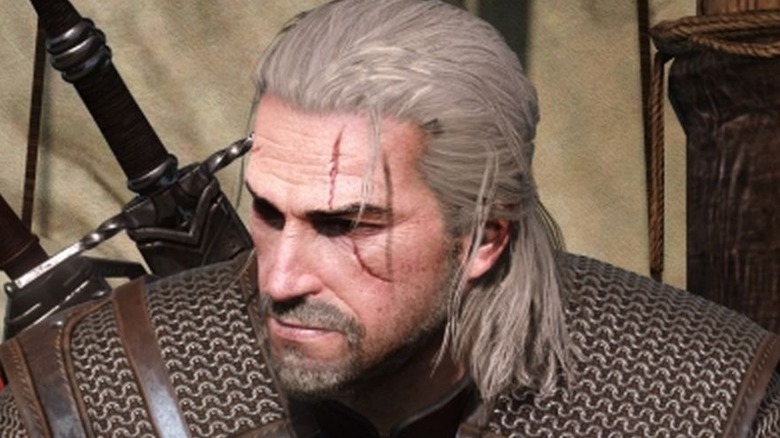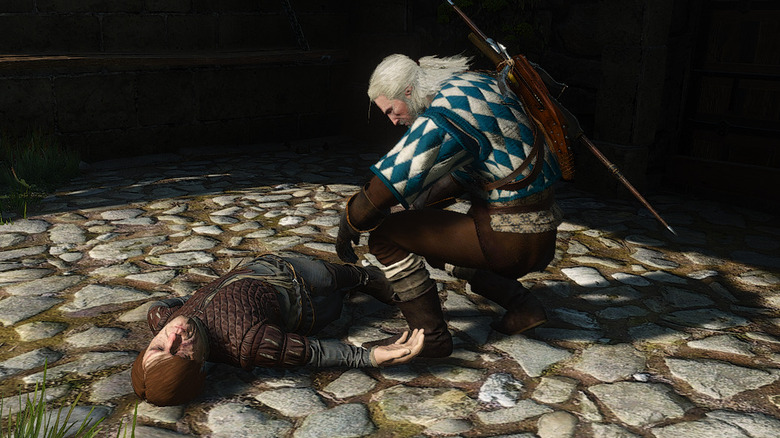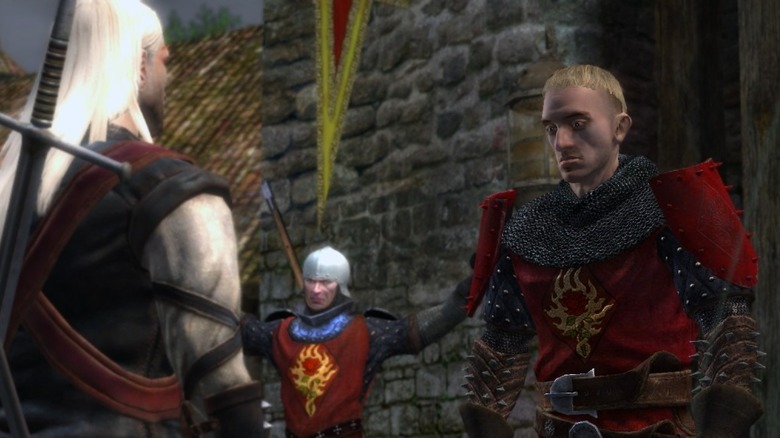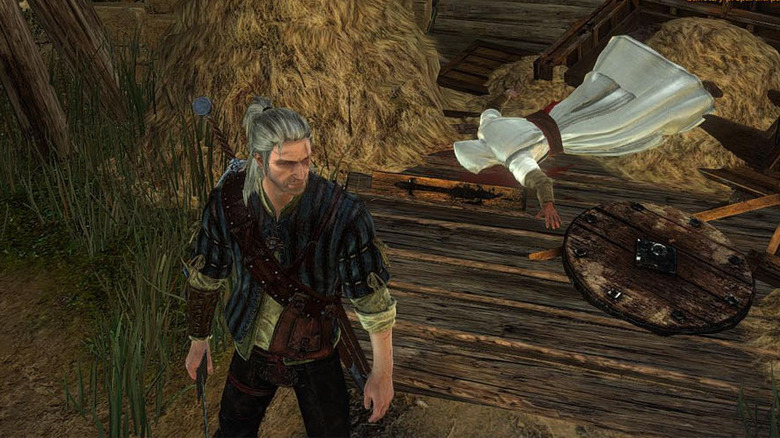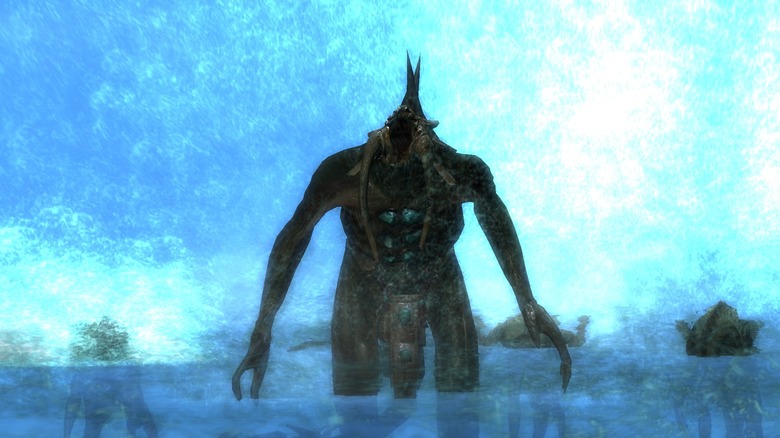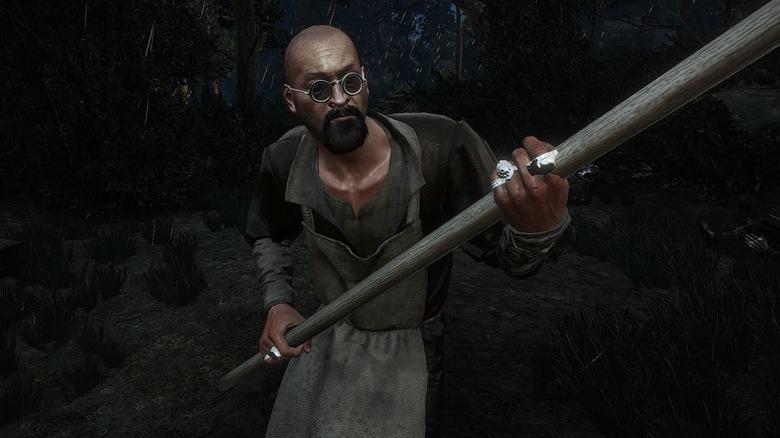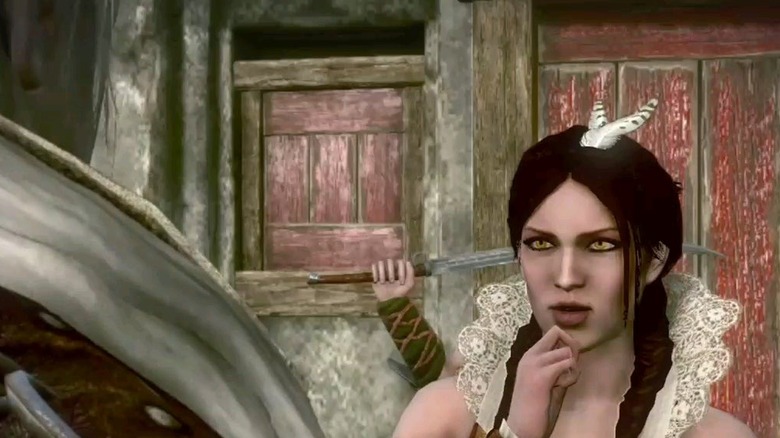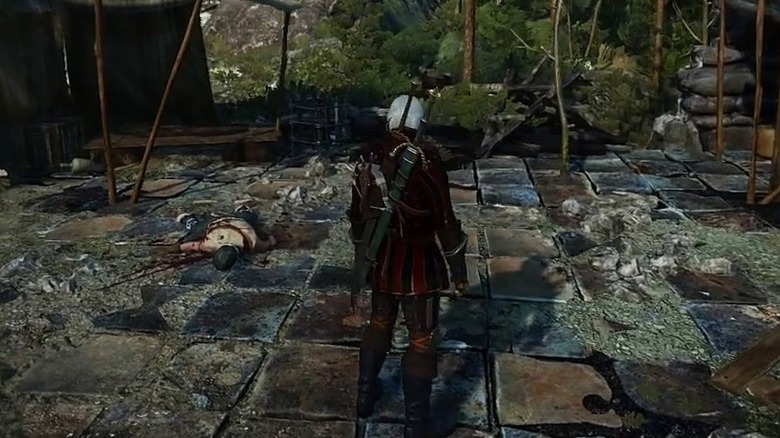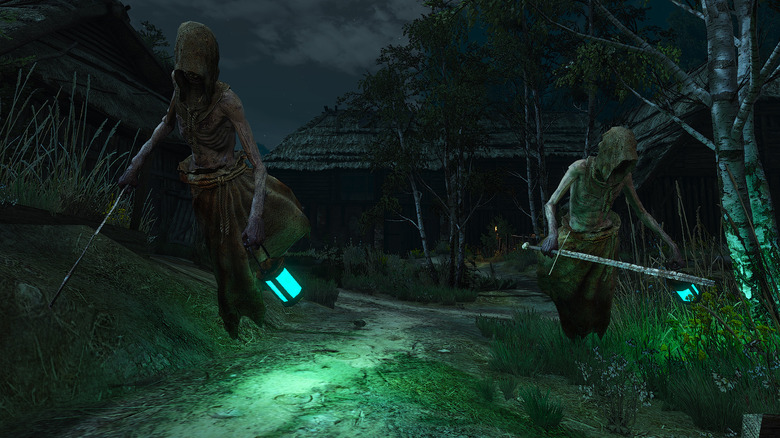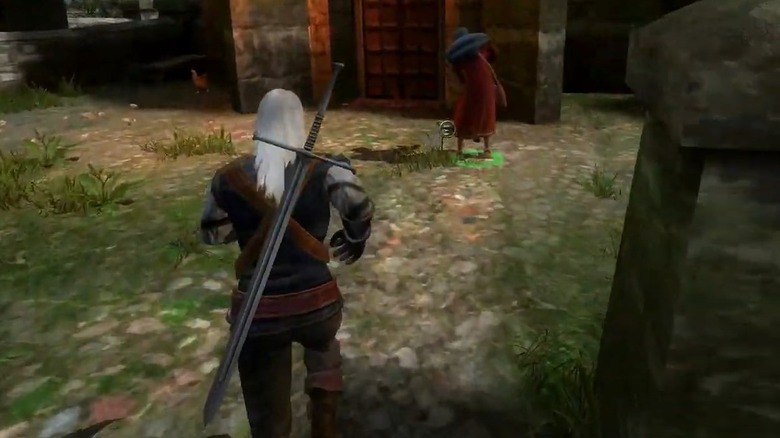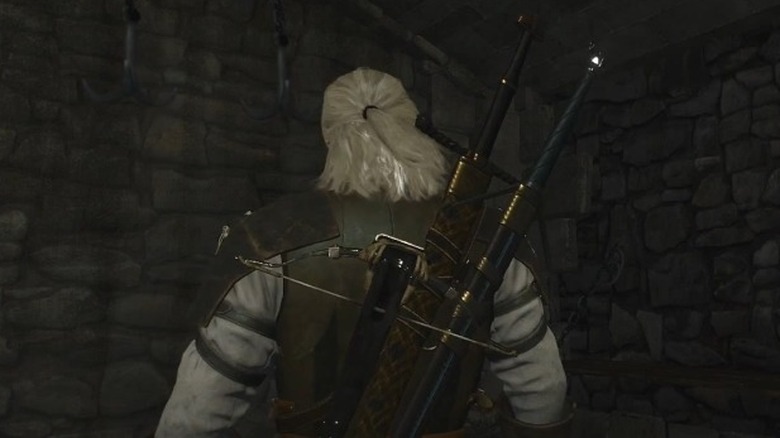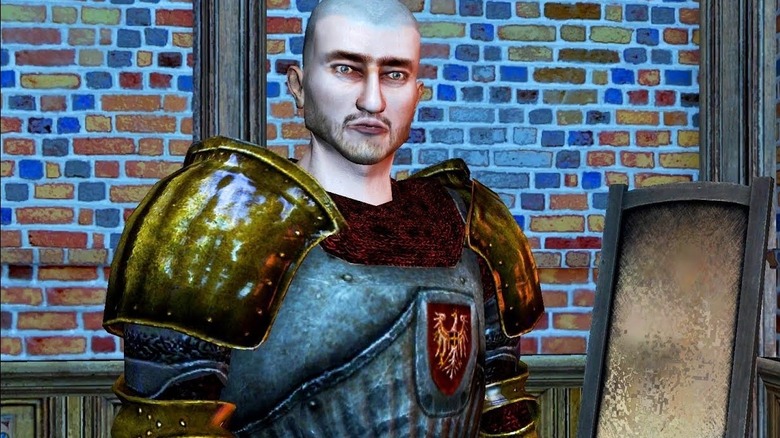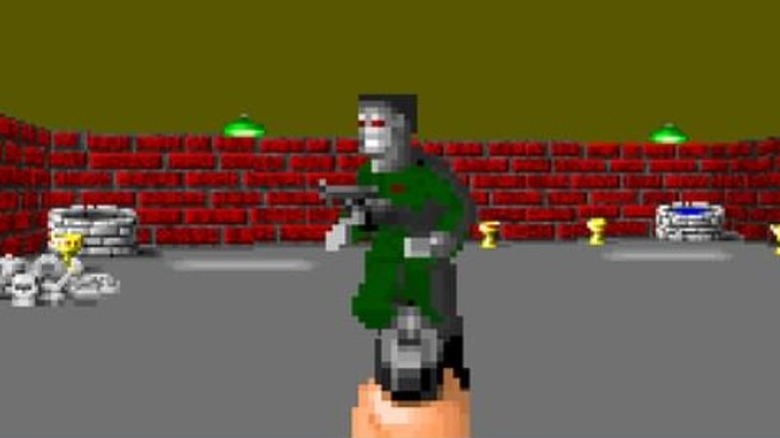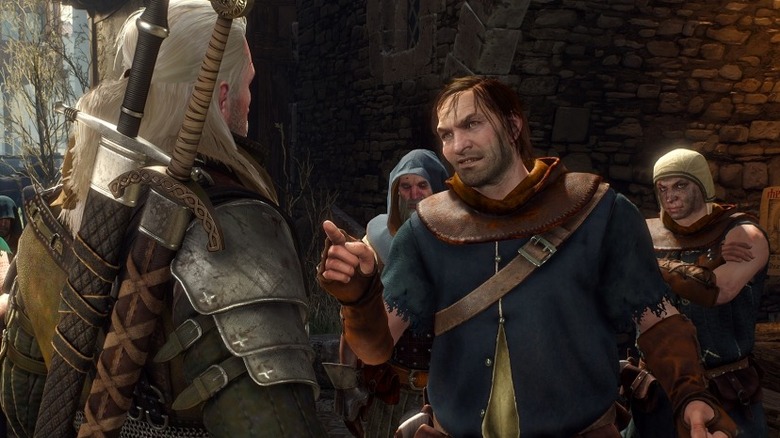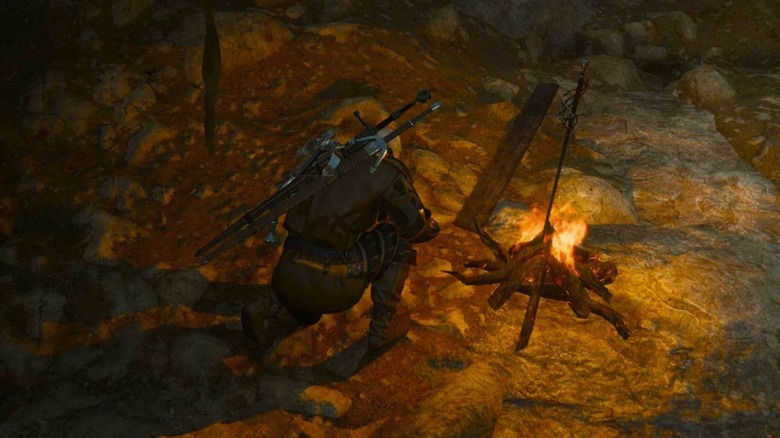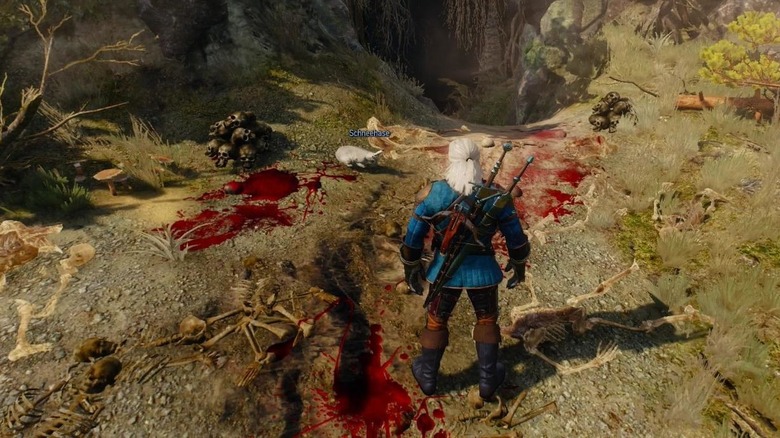Easter Eggs Only True Fans Noticed In The Witcher Games
Fans have flocked to "The Witcher" video games, books, and Netflix series in recent years, drawn in by its great characters and unique fantasy world. The game series has managed to have immense staying power, despite "The Witcher 3" being released back in 2015. The third entry from CD Projekt Red took the series to new heights and led many players to read the original novels by Polish author Andrzej Sapkowski or play the studio's previous two entries.
As newer fans go back and experience the story of Geralt of Rivia in its entirety, however, they will quickly find out there is a lot to learn outside of the main plot. These massive games have plenty of hidden secrets, references, and details that players can simply walk right past — or never get close to at all. As such, there are also a number of easter eggs spread throughout the series that even the most hardcore fans might miss.
The Death of Tyrion Lannister - The Witcher 3
When "Witcher 3" was released in 2015, HBO's "Game of Thrones" was one of the biggest shows on television. According to Business Insider, the finale of the show's fifth season in 2015 broke numerous records for both the series and HBO. Also based on a series of novels, "Game of Thrones" features a similarly dark tone to that of "The Witcher," so it makes a lot of sense that "The Witcher 3" might want to reference to its fantasy cousin.
The game ended up referencing a particular plot point for Peter Dinklage's fan-favorite character in the show, Tyrion Lannister. The easter egg is located in the sprawling archipelago of Skellige and recreates a moment from Season One of "Game of Thrones," albeit with a much worse ending for Tyrion (per PC Gamer).
Players who look hard enough can find Tyrion's corpse in a sky cell, a jail carved into a cliff face with one wall missing to allow cold winds and other harsh weather to blow in. In the show, Tyrion doesn't die in his sky cell, but it's no surprise that the torture method is more lethal in the harsh environment of Skellige.
Developer faces - The Witcher
With "The Witcher" video games taking place chronologically after the series of books, there are many established characters available for the developers' use. Whether it be soldiers who have earned a promotion or a noble that Geralt ran into once or twice before, fans of the novels are repeatedly treated to seeing their favorite side characters revisited in the video games. However, this means developers are also challenged with creating these many characters in believable ways that will satisfy fans.
To make this process a little bit easier, CD Projekt Red's first game based a handful of the characters' faces on developers working on the game. For instance, the Grandmaster of the Order of the Flaming Rose, Siegfried of Denesle, was based on game designer Konrad Tomaszkiewicz. Meanwhile, Raymond Maarloeve has the face of the team's head artist, Adam Badowski, and Roderick de Wett has the face of senior producer Tomasz Gop.
It is not often that players really get a good look at the team behind a game (beyond the end credits), so it's fun to see these devs get some literal recognition in the form of an easter egg.
The dead assassin - The Witcher 2
Before "The Witcher 2" dives into a narrative involving political conspiracies and diplomatic maneuvers, the game features a bombastic opening sequence, which sees Geralt of Rivia participating in the siege of Castle La Valette. The sequence serves as the game's tutorial as players navigate the siege camp, fight through waves of enemy soldiers, and eventually survive a dragon attack. There is a lot going on throughout the sequence, but players who take a break from the action to breathe and explore a bit can find a cheeky jab at one of Ubisoft's biggest video game franchises.
The easter egg can be found after players kill enemies defending one of the La Valette ballistas, tucked into a corner of a castle courtyard. There, Geralt can find a corpse on top of a broken cart filled with hay. The body is clearly dressed to resemble Altair from the "Assassin's Creed" series, and the discovery is accompanied by Geralt grumbling about how "they'll never learn."
To tie it all together, finding the easter egg also rewards Geralt with a permanent +1 boost to his "Assassin" attribute.
H.P. Lovecraft references - The Witcher 1, 2, 3
With how dark and dangerous the world and monsters of "The Witcher" are, it is no surprise that it would take some cues from iconic horror author H.P. Lovecraft, who was known primarily for his Cthulhu Mythos that centered on ancient and powerful gods.
The first game features the biggest reference by allowing players to actually fight and kill one of Lovecraft's ancient old ones, Dagon. Dagon is an underwater god that can be faced in Chapter 4. The beast is worshipped by a faction of the Vodyanoi and is one of the more punishing boss monsters in the game.
As noted by fans on ResetEra, "The Witcher 2" took a more subtle approach to referencing Lovecraft by including a book titled "De Vermis Mysteriis." In the game, the book is referenced as being purchased by the sorceress Sile de Tansarville. In the Cthulhu Mythos, the book is similar to Lovecraft's infamous Necronomicon and contains a number of spells that allow its wielders to summon astral beings and control them.
"The Witcher 3" takes a similar approach by mentioning a book titled "Liber Ivonis" in its "Blood and Wine" expansion. Found during the quest "A Knight's Tales," the book is referenced in Geralt's journal with a description that feels as though it is taken straight out of a Lovecraft work, referencing a shapeless world filled with terrible silhouettes and colors.
An alchemist breaks bad - The Witcher 3
Leading up to the release of "The Witcher 3," another of the biggest shows on television was AMC's "Breaking Bad." So, it only makes sense that the game has a couple of references to the meth-fueled crime drama, including an achievement named "Let's Cook!" (named for a famous line from the show). However, players can also find an alchemist with a story that is strikingly similar to that of Walter White.
In "Breaking Bad," Walter White is a high school chemistry teacher who works part-time at a car wash after school to make ends meet for his family. After being diagnosed with cancer, he begins making and selling drugs to make enough money to care for his family after he is gone.
In Novigrad, players can stumble upon a cave with an illusory wall, behind which there's a hidden chemistry lab and notes from the alchemist who owns it. The notes tell a story close to Walter's, including references to the Alchemist's assistant, Jester, who seems just as scatterbrained and troubled as Walter's assistant, Jesse Pinkman. The Alchemist also underwent a mental journey similar to Walter's, explaining his belief that it is better to die with a bang than slowly burn out.
Numerous Lord of the Rings references - The Witcher 2
"The Witcher 2" also houses a number of references to possibly the biggest fantasy property of all time, "The Lord of the Rings." The two biggest easter eggs can only be found if players work with the leader of the Scoia'tael, Iorveth. The first arrives when Geralt meets with Iorveth, who offers him a piece of the filling Lembas bread. However, Geralt doesn't seem to understand what Iorveth is referring to, so the two quickly move past it. But Geralt seems to be familiar with Tolkien's work later on, as he and Iorveth give a rough synopsis of the series' plot to the sorceress Philipa Eilhart after she asks them to get her some magic rings.
"Lord of the Rings" fans may also pick up on some smaller references throughout "The Witcher 2, like a unique blade called the Sword of the Dun Banner that is noted to have previously belonged to a Colonel Gondor. In an area known as the Old Mines, players can also find journal entries from the dwarf Balin, who references how the dwarves in the mine dug too deep and released a great evil. His third journal even goes so far as to repeat one of Gandalf's iconic lines: "Fly, you fools!"
Diablo in Novigrad - The Witcher 3
"The Witcher 3" also contains a few small nods towards "Diablo," Activision Blizzard's genre-defining action RPG series. This seems fitting, since the first game in "The Witcher" series was originally conceived as being very similar to "Diablo" (per Kotaku).
The first reference to "Diablo" comes in the form of the Relic sword Azure Wrath. Earned after killing a chort, the Azure Wrath is a silver sword with some solid stats, but it also shares the name of an iconic blade wielded by angels throughout all three "Diablo" titles.
The next "Diablo" easter egg in "The Witcher 3" is even more obscure. Players who want to hunt it down will have to travel to the town of Fyresdal, located on the southern shore of Ard Skellig. When Geralt walks into the village's butcher shop, the butcher will yell "Fresh Meat!" While many players will never find this easter egg (or think anything of it if they do see it), dedicated "Diablo" players may recognize the line as the opening one-liner of the games' Butcher boss.
The Fall of the House of Reardon - The Witcher 3
More literary references can be found in "The Witcher 3" throughout the side-quest "The Fall of the House of Reardon." Starting in Lindenvale, the quest sees Geralt helping Dolores Reardon free her family estate from a number of wraiths haunting it. The name of the quest is a clear nod to the short story "The Fall of the House of Usher" by Edgar Allan Poe, but there is also a reference to Poe's "The Cask of Amontillado" hidden in the quest.
"The Cask of Amontillado" tells the tale of a paranoid man killing a competitor (whom he believes caused the downfall of his family) by trapping him behind a wall and leaving him to die. While exploring, players can find a painting of Dolores and her twin brother Humbert, who has been absent from the story up to this point. However, curious players who go to the basement of the manor can destroy a weak wall to reveal the corpse of the brother, along with a note that describes how Dolores' husband killed him — just like in Poe's short story.
Interestingly, Dolores and Humbert's names also appear to be a reference to the novel "Lolita" by Nabokov, although none of the quest's plot seems to be inspired by that story.
Saving Private Ryan - The Witcher
"Saving Private Ryan," Steven Spielberg's World War 2 film from 1998, is iconic for its unflinching and realistic depiction of the horrors of the war, as well as its ability to show the humanity of those who fought it. There does not seem to be very much in common between the movie and "The Witcher," but eagle-eyed players can find a nod towards the film in "The Witcher."
The easter egg is located in the area known as the Outskirts in Vizima, where a church of the Eternal Fire sits. There, players working through the quest "Dead Hand of the Past" can speak with the Reverend they've been seeking. However, if players look up at the church's steeple, they may notice the small barrel of a Mauser sniper rifle protruding from inside. This is a reference to one of the most notorious scenes in "Saving Private Ryan." In this scene, soldiers attempt to hold off a much larger force of Nazi soldiers, with one of them going into the steeple of a church with a sniper rifle. While this is one of the smaller easter eggs in the game, the existence of a gun in this world undoubtedly makes it one of the more unexpected ones.
Baldur's Gate to Novigrad - The Witcher 3
"The Witcher 3" also houses a few fun nods to the classic roleplaying game "Baldur's Gate." One of these is a piece of junk in "The Witcher 3" called the Silver Pantaloons. Similar metal pants are a recurring item scattered about the maps in the "Baldur's Gate" series. They serve no purpse in "The Witcher 3" beyond a quick sale, but are still a fun easter egg for those in on the joke.
Players can also find a unique steel sword known as Daystar, which appears to another reference to "Baldur's Gate." The sword, which deals bonus fire damage and increases how much gold players find in their loot, is found after completing the contract "Muire D'yaeblen." In "Baldur's Gate," Daystar is a magical longsword made of silver that deals bonus damage against the undead or enemies with an evil alignment. It does seem a bit odd that "The Witcher 3" didn't also make its Daystar a silver sword, but both are useful gear for players to get their hands on, nonetheless.
A treat for readers of the book series - The Witcher
The very first game in the series can be a bit hard for players to go back to now. Its mechanics may have aged poorly to many modern players. However, it still has an engaging world to explore and a story that bridges the gap between the novels and the video game trilogy. This makes "The Witcher" pretty important for dedicated fans to play; without it, they will likely have some questions about how Geralt got to where he is in the second and third games.
For those dedicated fans, there are numerous references to the books throughout the first game, including a particularly big one at the very end. After the closing credits finish up, the player is treated to audio of a conversation between the Kings Radovid and Foltest. While players who did not read the books may not know what to make of it, those who have will recognize it as a verbatim recreation of a conversation between the two characters in the fourth book, "The Time of Contempt." For longtime fans of "Witcher" lore, hearing this dialogue fully-voiced and acted out is a great treat.
Wolfenstein 3D - The Witcher 2
In Chapter 2 of "The Witcher 2," players who chose to side with Vernon Roche can decide to tackle a quest titled "The Spear of Destiny." The quest sees Geralt working to end a blood curse placed on Sabrina Glevissig, which requires him to get his hands on the titular artifact, the Spear of Destiny. The spear is in the hands of a champion gambler named Skalen Burdon, who won it in a game of dice poker. Yes, this means that Geralt has to beat Skalen in a game of dice poker to win the artifact for himself, which is easier said than done.
The mini-game for dice poker in "The Witcher 2" is pretty difficult and heavily relies on luck, so most players will have to try multiple times before they can beat Skalen and get the spear. Still, players who challenge the champ will get to see a fun "Wolfenstein" easter egg.
When Skalen beats Geralt, he makes a fleeting remark about a man named Blazkowicz, who also tried to get the spear from him. This is a reference to classic FPS "Wolfenstein 3D," which starred protagonist B.J. Blazkowicz and featured a prequel chapter titled "Spear of Destiny." Additionally, Skalen has a unique sword that players can win called "Princess Xenthia," which seems to have been named in reference to the television series "Xena: Warrior Princess."
Geralt is a fan of the Duke - The Witcher 1, 2, 3
Another classic shooter referenced throughout the series is "Duke Nukem," a franchise well-known for its irreverent tone and its titular protagonist, who is constantly spouting one-liners and cracking vulgar jokes. "The Witcher 2" sees Geralt quote Duke pretty frequently. For instance, when players start fighting an enemy, one of the possible lines for Geralt to say is "Damn, you're ugly." This is an iconic Duke Nukem catchphrase that is heard throughout the games.
"The Witcher 3" also features bandits who sometimes borrow from Duke when they enter combat, yelling "I'll rip off your melon and s*** down your neck." Even though it comes from a classic sci-fi shooter, the line manages to fit in well with the vulgar world of "The Witcher." "The Witcher 3" also carries on the tradition of Geralt muttering "Damn, you're ugly," at the start of combat — a taunt that has gone on to become pretty synonymous with the series, thanks to the third game's popularity.
Geralt Restores His Humanity - The Witcher 3
"Dark Souls" is one of the most impactful video game series in recent years, its punishing combat mechanics and intricate world design taking hold in the hearts of many players and inspiring a number of other titles. Fittingly, the "Blood and Wine" expansion for "The Witcher 3" contains a reference to the series' bonfire system.
In "Dark Souls," players must rest at bonfires to heal and level up their characters, although doing so respawns all of the difficult enemies that the player has killed up to that point. The bonfires also serve as checkpoints; upon death, players will return to the bonfire where they last rested.
"The Witcher 3" emulates this very smoothly: Geralt is led to a similar-looking bonfire when he travels to a dimension comprised of twisted fairy tales. A small floating light takes him to the bonfire, where he gratefully sits at and rests, creating a new autosave. That way, if the player continues on their quest and dies, they'll be returned to the bonfire, making it feel almost like Geralt is in a "Souls" game.
Monty Python - The Witcher 1, 2, 3
The entire "Witcher" series also houses a number of easter eggs related to famous British comedy troupe Monty Python. The first game recreates one classic sketch in which two lumberjacks discuss cross-dressing. Additionally, beggars will occasionally yell that society made them what they are, a reference to the group's infamous "Dead Bishop" sketch.
"The Witcher 2" takes a more subtle approach in referencing the film "Monty Python and the Holy Grail" when a character says their injury is nothing more than "a flesh wound."
"The Witcher 3" references the same movie, including having an area where players can find a killer bunny responsible for slaughtering dozens of men. Bandits throughout the game may also borrow from the movie's insults by yelling to Geralt that his "mother was a hamster" and his "father smelled of elderberries." The side quest "Shock Therapy" also acts as a reference to the Monty Python movie "The Life of Brian" and sees Geralt trying to surprise a druid so that they break their oath of silence.

